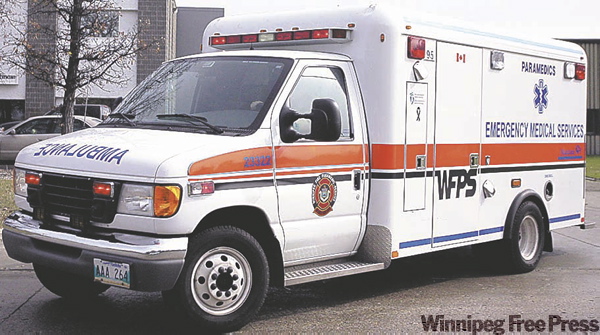Sedans may replace ambulances
Move mulled to free up ERs
Advertisement
Read this article for free:
or
Already have an account? Log in here »
To continue reading, please subscribe:
Monthly Digital Subscription
$0 for the first 4 weeks*
- Enjoy unlimited reading on winnipegfreepress.com
- Read the E-Edition, our digital replica newspaper
- Access News Break, our award-winning app
- Play interactive puzzles
*No charge for 4 weeks then price increases to the regular rate of $19.95 plus GST every four weeks. Offer available to new and qualified returning subscribers only. Cancel any time.
Monthly Digital Subscription
$4.99/week*
- Enjoy unlimited reading on winnipegfreepress.com
- Read the E-Edition, our digital replica newspaper
- Access News Break, our award-winning app
- Play interactive puzzles
*Billed as $19.95 plus GST every four weeks. Cancel any time.
To continue reading, please subscribe:
Add Free Press access to your Brandon Sun subscription for only an additional
$1 for the first 4 weeks*
*Your next subscription payment will increase by $1.00 and you will be charged $16.99 plus GST for four weeks. After four weeks, your payment will increase to $23.99 plus GST every four weeks.
Read unlimited articles for free today:
or
Already have an account? Log in here »
Hey there, time traveller!
This article was published 16/10/2009 (5931 days ago), so information in it may no longer be current.
Forget the huge white ambulance. Forget the lights and sirens. Forget the long wait to be handed off to an emergency room doctor.
Winnipeg paramedics could soon arrive at your door in a much homelier vehicle — a Ford Focus. If the provincial government approves the idea, a paramedic could be sent by car to triage and treat some of the thousands of non-life-threatening cases called in to 911 every year.
The move is part of a bold new plan meant to reduce pressure on city emergency rooms, ease the chronic shortage of paramedics and cope better with the looming H1N1 flu pandemic.

A Ford Focus could be on the streets in a few weeks, with five paramedics cruising the city in sedans by the time the worst of the pandemic hits, said Winnipeg Fire Paramedic Service Deputy Chief Ken Sim.
The city would still send a full-scale ambulance to critical cases, like heart attacks or car accidents. Those are only about 10 per cent of the cases medics attend.
The new "community paramedics" would act more like nurses who make house calls, responding to a whole host of less serious cases that don’t need a $1-million ambulance, two highly trained medics and an automatic trip to the nearest emergency room. That includes everything from worrisome flu to sprained ankles, diabetes and seizures.
The community medics would come equipped with most of the same gear an advanced-care paramedic carries, like medications and intravenous supplies.
However, they would use a slightly more sophisticated triage checklist like the one nurses use in the emergency rooms. Based on that checklist, the medics could treat someone on the spot, or call a taxi or stretcher service to transport someone to a clinic, or strap the patient into the Ford’s passenger seat and provide a lift to an urgent-care clinic or even the ER.
"We’d be able to get a trained paramedic to people sooner than having to wait for a two-person ambulance," Sim said.
Right now, patients with non-life-threatening problems can wait hours for an ambulance to arrive, in part because call volumes have increased nearly 15 per cent in the last five years. Call volumes plus delays off-loading patients in crowded emergency rooms have taxed Winnipeg’s paramedic service almost to the limit in recent years.
The WFPS is waiting for Health Minister Theresa Oswald to give the pilot project her approval.
Provincial regulations say patients can only be transported by ambulance, so the city needs a ministerial order allowing medics to give patients a lift in a Focus.
The province says it’s reviewing the proposal and hopes to have an answer for the WFPS in two weeks.
Paramedics have long been arguing for smarter ways to treat people who call 911 and they applaud the "community paramedic" approach.
"The idea is to have medics out in the community engaging people with problems and find the best place in health care for them instead of a system of ‘you call, we haul,’ " said paramedic union president Chris Broughton. "The system of emergency medicine has never really evolved over the years."
maryagnes.welch@freepress.mb.ca
By the numbers
55 per cent: Amount of time the average Winnipeg ambulance is in use by a patient. Senior city staff say this is "unparalleled in Canada."
38-40 per cent: Amount of time an ambulance ought to be in use, according to industry standards.
21: Number of ambulances on duty at peak times in city.
3: Longest number of hours a firefighter waited with a patient for an ambulance ride to hospital.
59: Number of minutes it takes paramedics on average to off-load patients at Health Sciences Centre.
— Source: WFPS


